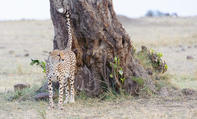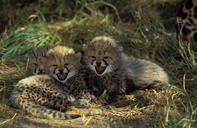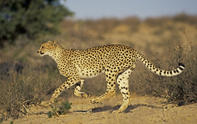Not Cat-like

Cheetahs are not considered social cats like lions but they do prefer to live in family groups, i.e. a female with her most recent litter, or in the case of the males, to cooperate as coalitions, usually groups of about three brothers, to reinforce their sway against other males.
Males have smaller territories than females, which they demarcate with urine and faeces and these overlap with areas regularly used by females although males will only accompany females when they are actually in oestrus.
Males cheetahs use ritualized threat displays to chase intruders away but will fight over females in heat with slaps of the front paws.
Good Moms

Cheetahs are considered attentive mothers and cubs, which are born in tall grass or other cleverly hidden sites after just three months gestation, will regularly be moved to remain undetected and free of parasite infestations.
The female painstakingly moves her cubs one at a time pinching them by the scruff of the neck, which relaxes the nerves in that area and calms the cubs as they travel. The female brings meat back to her litter when they are still as young as five weeks old and in just three months the cubs are completely weaned and by eight months old will begin to hunt and make their own kills.
Young cheetah cubs, up to three months old, have a mantle of grey fur along the saddle of their backs, which at a quick glance resembles the colouration of the formidable honey badger.
This mimicry is believed to deter larger predators from attacking the defenceless cubs as they are mistaken by predators for the more ferocious and generally avoided badger.
Nomadic

Cheetah cubs gain independence and begin fending for themselves at just eighteen months old. Before reaching an age at which cheetah can secure choice territories or settle into fixed home ranges, they become nomadic and wander great distances putting themselves at great risk to attack by other large predators.
Survival during this period is also compromised by competition with other cheetah and similar sized carnivores for food.
By Megan Emmett